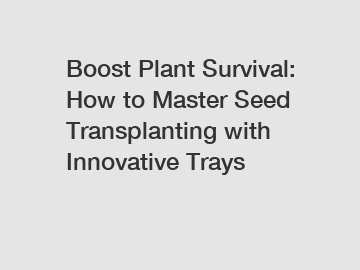Boost Plant Survival: How to Master Seed Transplanting with Innovative Trays
Boost Plant Survival: How to Master Seed Transplanting with Innovative Trays.
Seed transplanting is a vital step in the growth process of plants. It involves moving young seedlings from their initial growing containers to larger pots or directly into the ground. This delicate process can have a significant impact on the survival and growth of plants. To ensure success, innovative trays have been designed to optimize seed transplanting. In this article, we will explore the benefits of these innovative trays and provide valuable tips on mastering seed transplanting.
Benefits of Innovative Trays:

1. Improved Root Development:
When plants are transplanted, their root systems can be damaged. Innovative trays, such as biodegradable and root-training trays, have features that reduce root disturbance. Biodegradable trays are made from organic materials that allow roots to grow through the container walls, preventing damage during transplantation. Root-training trays have specialized grooved bottoms that guide roots to grow in a downward direction, resulting in stronger root systems that are better equipped to absorb nutrients and water from the soil.
2. Enhanced Air Pruning:
Traditional plastic seedling trays can lead to root circling, which hampers growth. Innovative trays utilize air pruning techniques to counteract this issue. Air pruning occurs when roots are exposed to air, causing them to stop growing and form new, lateral roots. This process prevents the formation of circling roots, ensuring a healthier and more expansive root system. Increased root growth allows plants to access more nutrients and water, leading to improved overall survival rates.
Tips for Successful Seed Transplanting:
1. Timing is Key:
Transplanting should be done at the right time to minimize stress on the plants. Seedlings should have developed strong roots and be large enough to handle transplantation, but not overly mature. As a general rule of thumb, wait until plants have 2-4 true leaves and a well-established root system before transplanting.
2. Handle with Care:
When removing seedlings from their original containers, it is crucial to handle them gently. Avoid pulling or tugging on the stem as this can cause damage. Instead, hold the seedling by its leaves, which are more resilient. It is also helpful to moisten the soil beforehand to ease the removal process.
3. Transplanting Technique:
Ensure the new container or planting hole is deep and wide enough to accommodate the roots without bending or crowding them. Place the seedling in the center of the container or hole and gently fill it with soil, lightly pressing down to remove any air pockets. Water the transplanted seedlings thoroughly to help settle the soil and hydrate the plants.
Conclusion:
Mastering seed transplanting is essential for boosting plant survival rates. By utilizing innovative trays, such as biodegradable and root-training trays, root damage can be minimized, resulting in improved root development and enhanced overall plant health. Additionally, adhering to proper timing and transplanting techniques can further increase the success of this crucial gardening step. For more information on innovative trays or seed transplanting, please contact us. Your plants deserve the best start in their journey towards growth and productivity.
Contact us for more information on innovative trays or seed transplanting techniques.
Want more information on heavy duty seed starting trays, germination trays supplier, best seed starter kits? Feel free to contact us.
146
0
0


Comments
All Comments (0)